How to make a Tudor wafer
Well, now for something completely different. Although it’s being shown on the telly at the moment, we actually finished all our work on that dancing series back in the summer, and my mind has moved onto other things. I’ve been busy recently with a new Tudor project.
This week I had the pleasure of watching my clever food historian colleague Marc Meltonville demonstrate the making of Tudor wafers in the Great Kitchen at Hampton Court. (BTW, Hilary Mantel is rather brilliant at describing food, and you might recall the memorable passage about wafer-making in Wolf Hall.)
Wafers were produced by the Yeomen of the Wafery in the ‘Wafery’ itself, a warm dry room in the Hampton Court kitchens that was near the other confectionary offices. Wafers are high-status food, involving specialist skills, great heat, and a quick turnaround. We’re essentially talking here about the kind of wafer you’d find today in an ice cream cone. Without sugar, you can use wafers in communion. With sugar, they’re a sort of Tudor canapé or snack, though if you use LOTS of sugar they’ll stick to the wafer iron and you’ll get into a mess. Here’s Marc showing us how to do it…
Get together your batter: eggs, flour, water, (a bit of) sugar, cinnamon.
Then, heat up your charcoal brazier by filling it up with embers from the fire and puffing them into life with a bellows. Try not to set fire to the bellows, as we did.
Get your wafer iron smokin’ hot … shaky focus on this one as I was leaping back away from the smoke!
Put a dollop of batter into the fire and spread it about a bit. Then close the iron and squeeze.
Of course the prototype’s going to get burned…
But once you’ve got the hang of it, you take a good one and cut out a lovely circle using a cup.
And hey presto, there’s your Tudor wafer! It’s served with wine and a plate of spices, so I guess you dip it in the wine and then into the spices and then gobble it up.



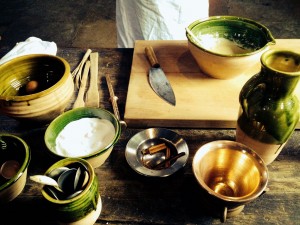
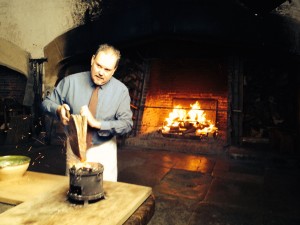
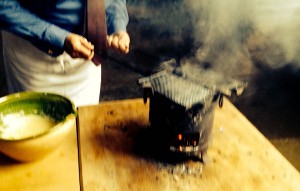
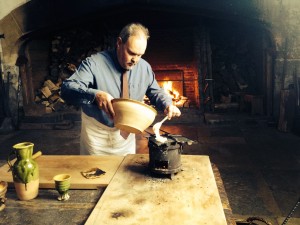
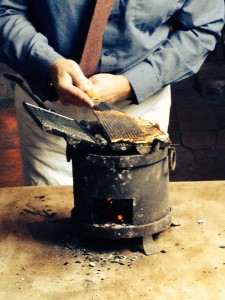
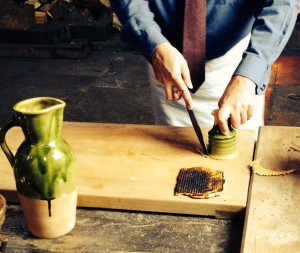
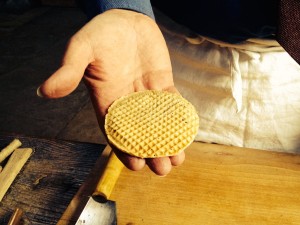



Ah! Then I got to the bit where you dip it in wine and it all seemed worthwhile!
I suspect the prototypes were an extra treat for the cooks, kitchen maids and maybe even the lowly scullery maid. Serve the King burnt wafers at your own peril….
Lucy, thank you for this, another fascinating gem. Linked with you latest Tweet, it encourages me to delve into the mysteries of cookery and baking tho I doubt I’ll ever rival your skill.
PS: got the ‘Tea’ book with your Foreword yesterday.
wow! the first waffle maker. Amazing!
it LOOKS fine , but surely that wouldn’t have gone far with Henry VIII?
The film ‘Man for All Seasons’ (Dir. Fred Zinneman, 1966) won Six oscars. I wonder if some of the filming was done outside Hampton Court?
Put two of these together with a caramel type filling andhey presto you have a Dutch Stroopen Waffle. Delicious with cold Genever gin but good with anything really
Sounds good to me Lucy.
Keep gracing our televisions screens, love your cheery humour.
just read the passage about wafer making in Wolf Hall. The Italian waffle cookie, pizzelles, immediately came to mind. Fascinating to see this obvious early prototype. Could the Tudors have learned this in Italy?
Just been diverted to this site from Future Learn History of food. These could be made using a BBQ today, must try it.
Wonder where you can purchase a wafer maker and get the recipe for wafers? Sounds interesting! Imagine it is something like a waffle ice cream cone but flat.
What ratios of sugar, eggs, flour and water did you use?
I’ve got a Swedish waffle maker at home that makes wafers that look exactly like this. Vafflor are thin crispy waffles and they even have waffle day on March 25th. The waffles have been around since Medieval times so I’m guessing the wafers are related in some way. http://www.scandikitchen.co.uk/frasvafflor-crispy-swedish-waffles/
A bit like making pancakes , the first one is always messed up
I didn’t know they had that type of side folding wafer iron or that the then cut them round. Very interesting. Thanks you